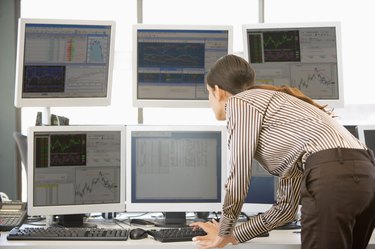
Economics and finance have undergone radical changes during the Information Age -- both in practice and in study. The ever-increasing computational and predictive capabilities of modern computers have made them invaluable tools for researching economic trends and developing strategies around them. Computational economics, a convergence of computer technology and economic theory, has changed the way companies and governments assess their economies.
Computational Finance
Video of the Day
Computational finance is an interdisciplinary process that incorporates elements of mathematical science, economic theory, statistics, and computer simulation and modeling. The applications for computational finance are varied, but they typically focus on investment planning and risk management. Using available statistical data, computers generate simulations that show the outcomes of investments under various situations and the potential for gains and losses. Using this information, companies develop plans to minimize potential losses and prepare for the different scenarios that may occur.
Video of the Day
Economic Forecasting
Computers are used in the creation of complex forecasting models. As in computational finance, computer simulations and models can be used to predict how markets will change. While no forecast is completely reliable, these forecasts factor a diverse array of variables in a fraction of the time a human could manually crunch the numbers. Current policies and models can also be quickly adapted to changing situations with new predictions available almost instantly and ready for assessment.
Online Trading and E-Commerce
The emergence of e-commerce and online trading of goods, services and stocks has considerably changed the way we do business. Many transactions, especially those between two businesses as opposed to a business and a consumer, are now performed online, with the exchange of information and digital purchases taking place instantly. This has vastly changed the way stocks are traded, as enormous bulk trades can be made the instant prices change, and exchanges are made based on computer algorithms with preset parameters rather than based on instructions to a human trader.
Data Presentation
The presentation of statistical and financial data has evolved with the involvement of computers. The mountains of data, which in their raw form constitute a decidedly bland list of numbers and figures, can be visually displayed with charts and graphs. The charts convey both data and relational concepts, making the information easier to understand for anyone involved in analysis. While creating these charts required careful attention to detail for accuracy in the past, modern software automates the process, accelerating the generation of accurate and visually dynamic presentations and charts.